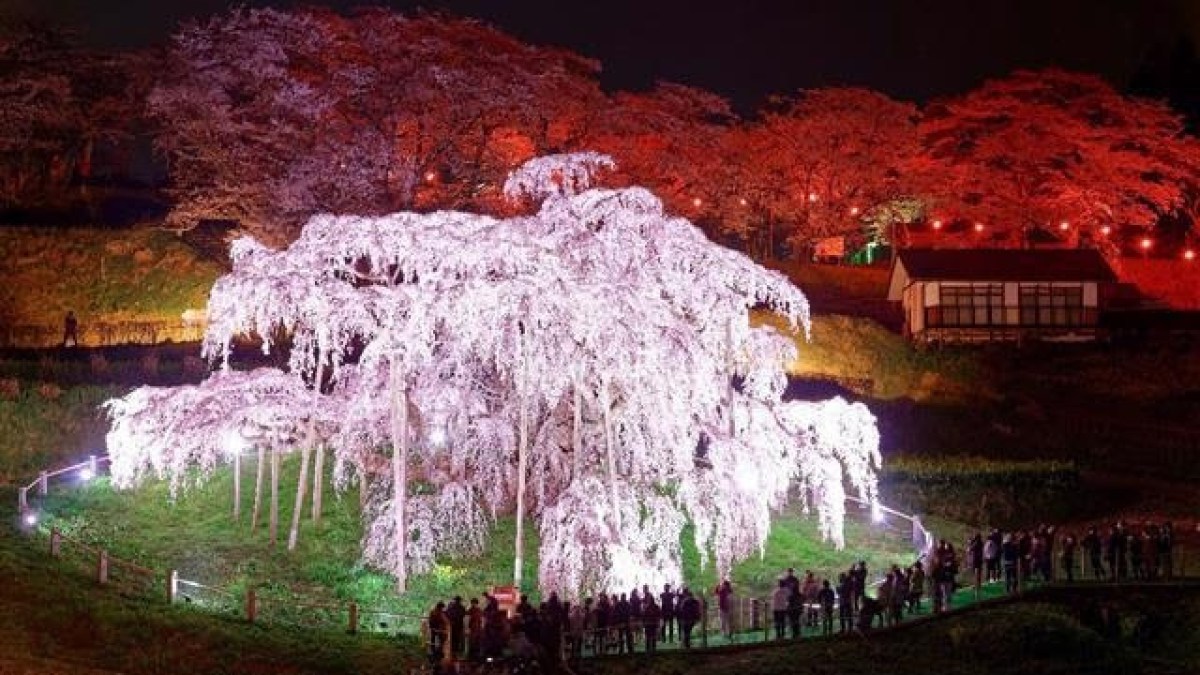One of the sakura trees in Fukushima was designated a national monument in 1922 (German)
Many people dream of visiting Japan during the cherry blossom season, or sakura, which bloom in specific seasons.
Every year, Japanese meteorologists track the opening of sakura flowers to predict when they will peak in bloom across the country, from the warmer southern regions to the cooler parts later in the season.
Japanese meteorologists monitor the opening date of sakura flowers every year to predict the peak date of their blooming and flowering (French)
The magic of sakura flowers
The new Shinkansen (bullet train) route linking Tokyo and Fukui was launched on March 16, making it easier to visit the Maruka Castle Cherry Blossom Festival.
The festival is held from the end of March to the beginning of April every year, and is a special occasion to enjoy the splendor of the spring season among the flowers and the scent of plants, and also an opportunity to see the oldest castle tower in the region, which dates back to the early 17th century.
By day, you'll see a sea of pink flowers dancing on the branches of cherry trees.
At night, the flowers themselves are illuminated to offer visitors a completely different experience, as 300 “Bonburi” paper lanterns are illuminated, and cartography is displayed on the roof of the tower with images inspired by the castle’s legends and history, which is an interesting modern addition to viewing the traditional cherry blossoms.
Stories told by Miharu Takizakura
If trees could tell stories, the Miharu Takizakura clan would have thousands of stories to tell.
The Takizakura waterfall-shaped cherry tree, so beloved by everyone, has been blooming here for more than 10 centuries. Named after the way its branches and twigs grow, it is a source of pride for the 17,000 residents of the small farming town of Miharu in Fukushima.
Designated a national monument in 1922, the tree stands more than 13.5 meters tall and extends 25 metres, supported by wooden crutches that keep its ancient branches intact.
The tree looks more beautiful when its natural colors stand out in the daylight, and its magic is no less during the day than at night, when it is illuminated with lights that enchant hearts.
The Miharu Takizakura tree is one of the “three main cherry trees” in Japan, and it is a special place to see the beauty of sakura and imagine all the events that this tree has experienced during its thousand-year life until now.
Popular wagashi sweets include “hanami dango,” which are tri-colored mochi rice balls in beautiful shades of pink, white, and green (German)
Traditional sweets with flowers
In the spring in Japan, tourists don't just see or taste the cherry blossoms. Throughout the country, the color and flavor of sakura blossoms find their way into everything from cakes to coffee.
It's the right time of year to try traditional Japanese handmade wagashi sweets.
One popular type of wagashi is “hanami dango,” tri-colored mochi rice balls in pretty shades of pink, white, and green, served on sticks and available almost everywhere, in convenience stores and specialty sweet shops alike.
Try sakura mochi, another type of sticky rice dessert, wrapped in salt-pickled cherry blossom leaves.
In Tokyo specifically, tourists are advised to go to the “Sakura Mochi Chumiji” sweets shop in the “Sumida” district to taste the sakura mochi, which they have been making since 1717.
Sakura yōkan is another popular springtime dessert made from small lumps of bean paste, which resemble jelly and some of which contain real cherry blossoms.
Toraya, a confectionery shop founded in Kyoto in the 16th century, is a great place to try yōkan along with other seasonal handmade sweets.
The "Yakuyun" wooden gate is 400 years old. The building dates back 350 years and is made of wooden beams and columns without a single nail (German)
Connection to the land and nature
In rural Yamagata Prefecture in northern Japan, Yamagata the Takenami is the place to feel connected to the land and nature, especially in the spring.
Tourists are advised to enter through the 400-year-old Yakoi Mon wooden gate, as the main building dates back 350 years and is made of wooden beams and columns without a single nail.
The interior designs combine Japanese traditions with modern Scandinavian furniture, while the sakura tree rooms overlook directly the gardens and cherry trees, giving guests a stunning view of the hanami flowers. The comfortable and modern guest room, as well as from inside the hot water in the private outdoor stone onsen bath. .
This resort is deeply rooted in its location, with hot water drawn from the surrounding mountains and food sourced from local farms and producers, including organic rice and local beef.
Source: Al Jazeera + German

